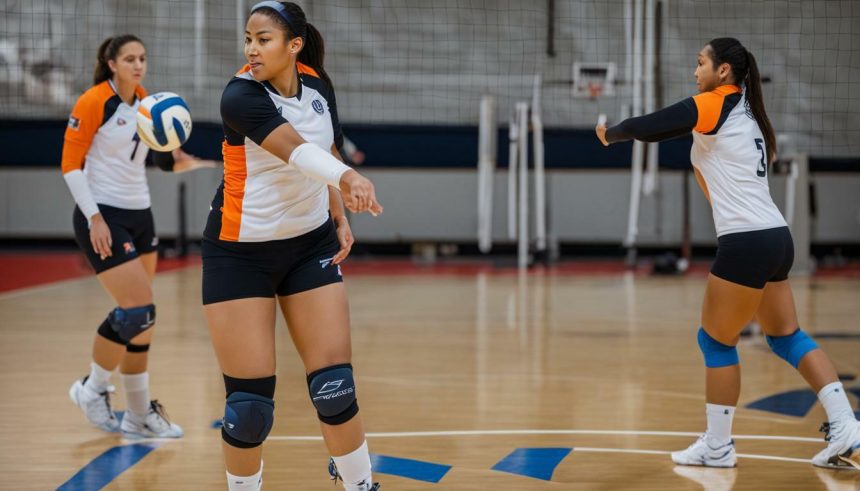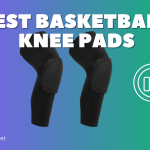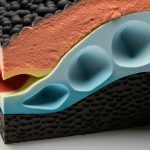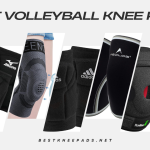As a volleyball player, you know that the game requires a lot of knee movement and contact with the floor. Knee pads can provide crucial protection against injury and enhance your performance on the court. However, wearing knee pads improperly or choosing the wrong ones can be just as harmful as not wearing them at all. Here, we will guide you through the correct method of wearing knee pads in volleyball, so you can enjoy the game safely and comfortably.
Key Takeaways
- Properly wearing knee pads is essential for safety and performance in volleyball.
- Choosing the right knee pads is crucial for fit, comfort, and protection.
- Measuring your knee circumference is important for finding the perfect fit.
- Putting on knee pads correctly is necessary for maximum coverage and security.
- Adjusting knee pads for a snug fit will enhance comfort and stability during the game.
Choosing the Right Knee Pads
When it comes to choosing knee pads for volleyball, there are a few considerations to keep in mind. The right knee pads can provide the necessary protection and comfort for a safe and enjoyable game.
Firstly, look for knee pads that are specifically designed for volleyball. These will have features that cater to the sport’s unique demands, such as shock absorption and flexibility.
Next, consider the fit of the knee pads. An ill-fitting knee pad can cause discomfort and limit mobility, so it’s important to find ones that feel snug but not constrictive. Take the time to measure your knee circumference before buying knee pads to ensure you get the right size.
Finally, consider the type of padding in the knee pads. Some pads use foam or gel for added cushioning, while others have a harder shell for maximum protection. The type of padding you choose will depend on your personal preferences and the level of protection you need.
Measuring for the Perfect Fit
Proper sizing is essential to ensure that your knee pads will provide optimal protection and mobility on the court. Before purchasing knee pads, it is vital to measure the circumference of your knee accurately. Here’s how to measure for the perfect fit:
Gather your materials
You will need a measuring tape and a pen or marker.
Find the center of your knee cap
With your leg bent at around 90 degrees, locate the center of your knee cap. You can do this by running your fingers along the knee until you feel the rounded part in the middle.
Measure the circumference of your knee
Wrap the measuring tape around your leg at the very center of your knee cap. Make sure that the tape is snug but not too tight, and that it is parallel to the ground. Take note of the measurement in inches.
Refer to the manufacturer’s size chart
Using your knee circumference measurement, refer to the manufacturer’s size chart to determine the appropriate size of knee pads you require. If your measurement falls between two sizes, it is usually best to opt for the larger size.
Try on the knee pads
Once you have chosen the right size, try on the knee pads to ensure that they fit correctly. The knee pads should be snug but not constricting, and they should not slip or slide while playing.
By following these steps, you can ensure that your knee pads fit properly, providing the right level of protection and allowing you to move comfortably on the court.
Putting on Knee Pads Correctly
Now that you have chosen the right knee pads and measured for the perfect fit, it’s time to put them on correctly. This will ensure that they are secure and provide maximum coverage.
Step 1: Roll Down Socks
Before putting on knee pads, make sure to roll down your socks to expose your knees.
Step 2: Position Knee Pads
Position the knee pads so that the padded portion is centered over your kneecap. The top of the knee pad should be 1-2 inches above your kneecap, while the bottom of the pad should cover the top of your shin.
Step 3: Pull Up Knee Pad
While holding the top and bottom of the knee pad, pull it up over your knee. The knee pad should fit snugly, but not too tight that it restricts movement or blood flow.
Step 4: Repeat for Other Knee
Repeat steps 2 and 3 for the other knee pad until both are securely in place.
It’s important to ensure that the knee pads remain in place throughout the game. If they shift or slide down, adjust them between plays to maintain proper coverage.
Now that your knee pads are securely in place, you can focus on playing your best without worrying about knee injuries.
Adjusting Knee Pads for a Snug Fit
Even with the right fit, knee pads may require some adjustments to ensure a snug fit throughout the game. To achieve this, start by pulling your knee pads up to your desired height, making sure they cover your patella.
Next, check the straps for any twists or kinks. This can cause discomfort and even restrict circulation, so it is essential to smoothen them out before fastening. Then, wrap the straps around the back of your knee and secure them tightly, but not too tight that it feels constricting. If your knee pads have an elastic sleeve, make sure it is not too loose or too tight.
If you find that your knee pads are moving around, try readjusting the straps or sleeve before resorting to taking them off. Remember that knee pads should stay in place during the entire game, so take the time to get them right before stepping on the court to maximize their effectiveness.
Additional Tips for Adjusting Knee Pads
For a more customized fit, look for knee pads with adjustable straps or ones that come with extra pads for added protection. You can also experiment with different heights and tightness levels to find what works best for you.
Don’t forget to check for any signs of wear and tear, such as holes or loose stitching, as this can affect the fit and protection they provide. Regularly maintaining your knee pads by washing and drying them according to the manufacturer’s instructions can also ensure that they remain in good condition for longer.
By following these tips, you can adjust your knee pads for a snug and comfortable fit, giving you the confidence to play your best on the volleyball court.
Maintaining Knee Pads for Longevity
Proper maintenance is crucial to increase the lifespan of your knee pads and maximize their effectiveness.
Cleaning Your Knee Pads
After each use, it’s essential to clean your knee pads to remove any dirt, sweat, or bacteria. Use a gentle soap and warm water to hand wash them, avoiding any harsh chemicals that could damage the material.
It’s best to avoid machine washing or drying your knee pads, as this can cause them to lose shape and effectiveness. Instead, let them air dry naturally, away from direct heat or sunlight.
Storing Your Knee Pads
Proper storage can also help prolong the lifespan of your knee pads. It’s best to keep them in a dry, cool place, away from any direct sunlight or heat sources.
Avoid storing them in a damp or humid environment, as this can lead to mold or mildew growth. If possible, store them in a mesh bag to allow for air circulation and prevent any odors.
Checking for Damage
Regularly inspect your knee pads for any signs of wear and tear. If you notice any holes, tears, or cracks, it’s time to replace them.
Continuing to use damaged knee pads can decrease their effectiveness and increase the risk of injury.
Conclusion
By following these tips for maintaining and caring for your knee pads, you can ensure their longevity and effectiveness in protecting your knees during volleyball games.
Benefits of Wearing Knee Pads
Wearing knee pads while playing volleyball comes with numerous benefits that can enhance your game and overall experience on the court.
Firstly, knee pads provide crucial protection against impact and friction when playing on hard surfaces. During the fast-paced and dynamic nature of volleyball, players frequently fall, dive, and slide on the floor, increasing the risk of knee injuries. Knee pads serve as a cushion between the knees and the ground, absorbing shock and reducing the likelihood of scraping or bruising.
Secondly, knee pads increase confidence and performance. By providing a sense of security, players can focus on the game rather than worrying about potential injuries. With a full range of movement and mobility, players can perform movements with ease, such as lunging, diving, and jumping.
Thirdly, knee pads offer long-term benefits by preventing knee problems in the future. Consistently playing without proper protection can lead to long-term knee damage, such as patellar tendonitis and meniscus tears. Using knee pads regularly can minimize the risk of developing these injuries, allowing players to enjoy volleyball for years to come.
In summary, the benefits of wearing knee pads in volleyball include injury prevention, increased confidence, and long-term knee health. By incorporating knee pads into your gear, you can enhance your performance on the court and reduce the risk of serious injuries.
Conclusion
As we have discussed, wearing knee pads correctly is crucial for safety and performance in volleyball. By choosing the right knee pads, measuring for the perfect fit, and putting them on properly, you can enhance your game and minimize the risk of knee injuries. Remember to adjust your knee pads for a snug fit and maintain them regularly to ensure longevity.
Benefits of Wearing Knee Pads
Not only do knee pads provide protection, but they can also improve your game in various ways. By absorbing impact and reducing stress on your knees, knee pads can prevent injuries and keep you playing at your best. Additionally, wearing knee pads can give you increased confidence on the court, allowing you to move more freely and fearlessly.
Overall, incorporating knee pads into your volleyball gear is a smart and beneficial decision. With proper usage and maintenance, knee pads can enhance your safety, performance, and enjoyment of the game.










